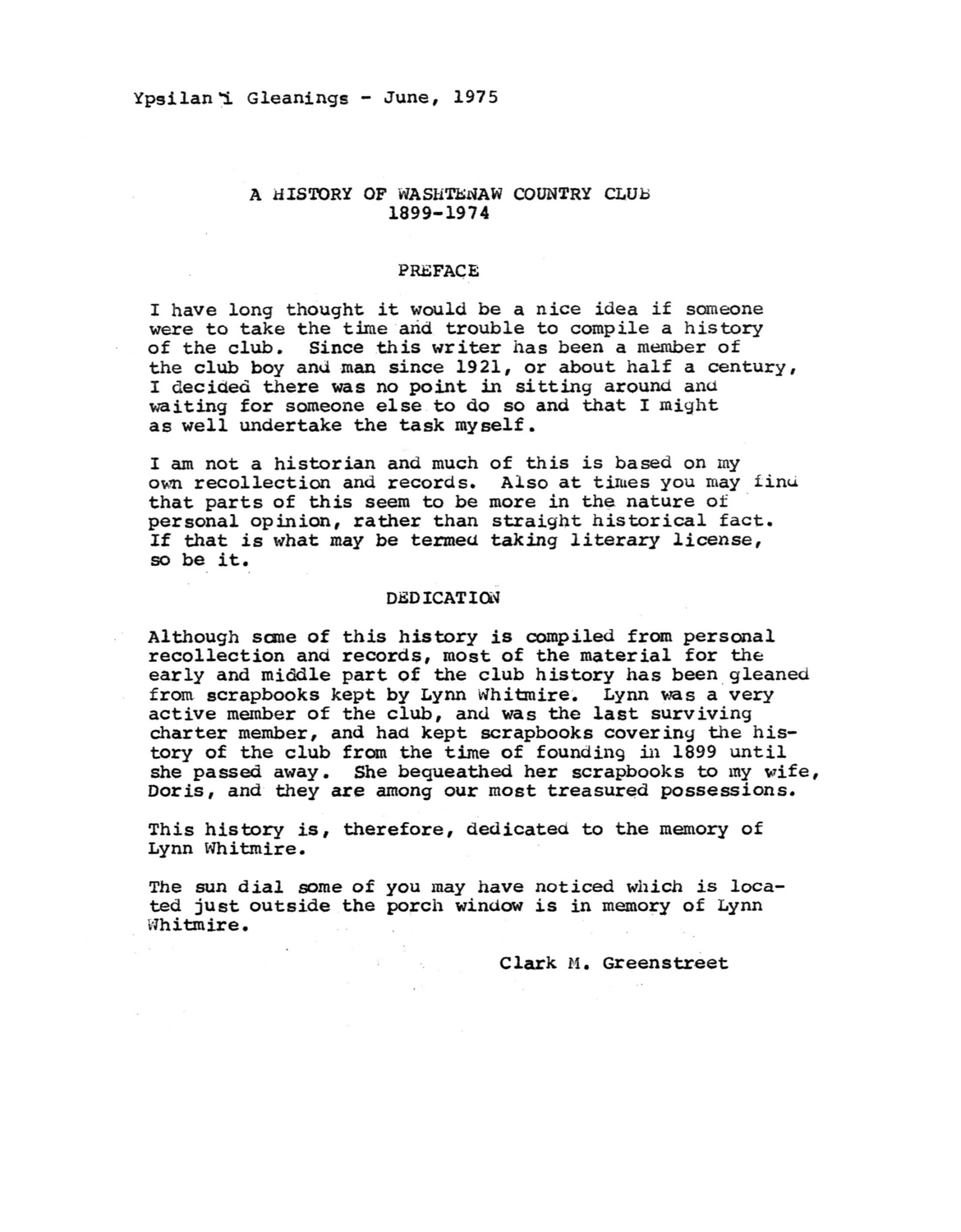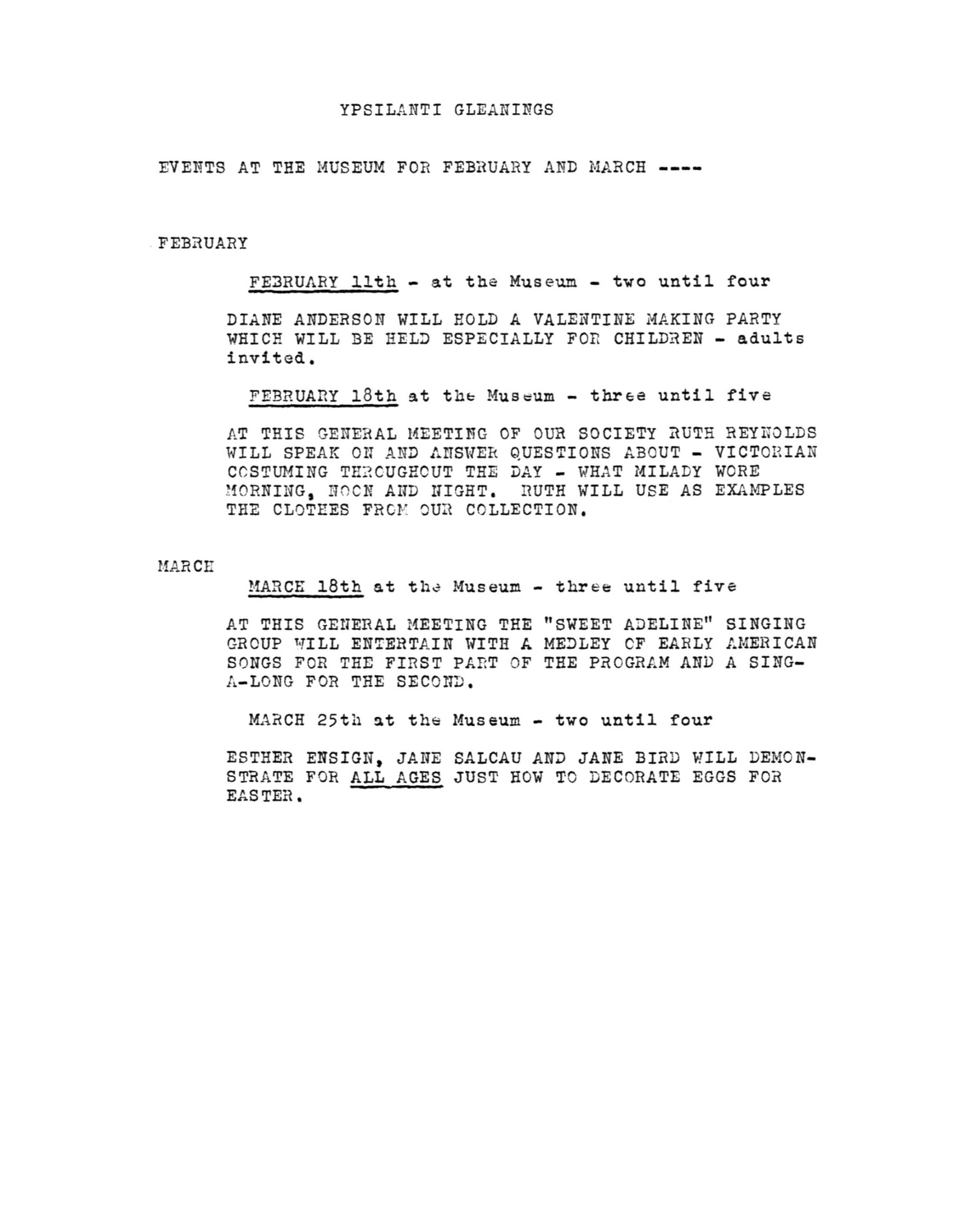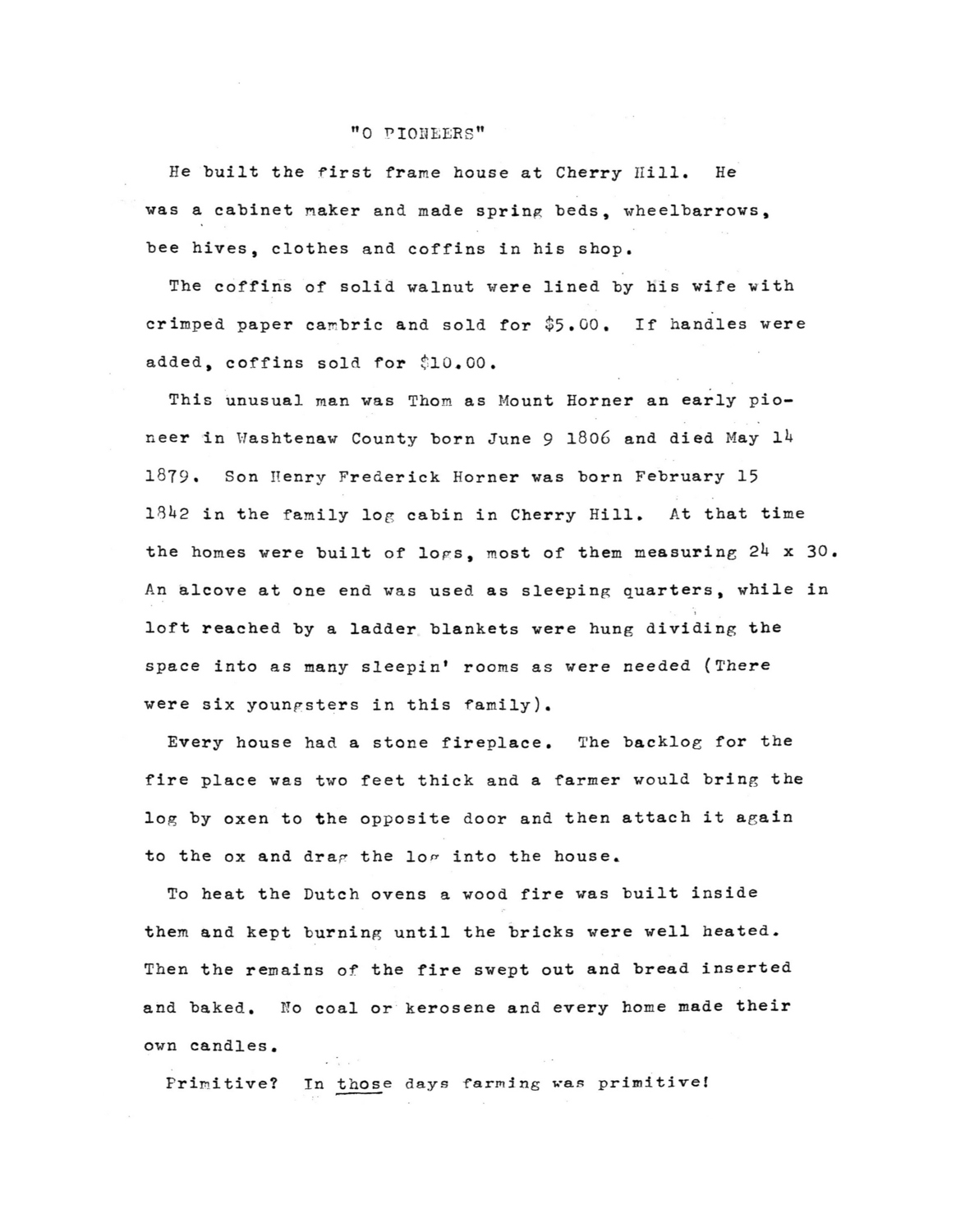Ypsilanti Gleanings, July 1975: A History of Washtenaw Country Club, 1899-1974

Weinberg's Peony Garden
On Ann Arbor's west side, there once flourished an amazing garden which, from 1920 until 1952, was one of the city's notable beauty spots. Weinberg's peony garden, as it was known, also included poppies, irises, and lilacs. Its landscaping included many favorite picturesque features of the 1920s: a sunken garden, a rock garden, and a fish pond with water lilies. Owner Carl Weinberg had started the garden behind his house at 514 South Seventh and gradually extended it until it covered an area bounded by Jefferson Court to the north and Lutz to the south, stretching from Seventh all the way to Eberwhite.
Peonies were Carl Weinberg's favorite flower. He grew many species, including some exotic specimens like a Japanese tree peony and an Alice Harding peony from Nice, for which he is said to have paid $250. Weinberg himself developed some new peony strains, which he named for friends and relatives. A double white peony is named after his wife, Elenora; another is named after his nephew, Bobby Faust, and a third after Andrew Muehlig, his friend. A dark red poppy he named after himself.
The garden's main commercial activity was selling cut flowers to florists like Nielsen's. Roots for planting stock were also sold. But the garden was much more than a business. It was an Ann Arbor landmark and a passion for its owner. People often came to the garden just to enjoy walking through it, especially on weekends. Friends recall Weinberg giving away more flowers than he actually sold. Flowers often appeared at Bertha Muehlig's store and at her brother's funeral parlor. Weddings were sometimes held in the gardens, and neighborhood teenagers earned pocket money by weeding and spraying there.
Carl Weinberg could afford to be generous. His main source of income was a successful contracting business. He grew up in the house at 514 South Seventh and at first worked as a foreman for his older brother, Fred, a contractor and also proprietor of Weinberg's skating rink (now the U-M Coliseum) and swimming pool. When Fred died in 1917, Carl, then thirty-seven, went into the construction business for himself, joining with mason Walter Kurtz. Their firm was on Jefferson Court, behind Weinberg's house. (The old block buildings now house Butcher and Willits Construction.) The horses that pulled the equipment were stabled in the big stone barn behind Kurtz's house at 520 First Street. Later, Kurtz moved to 500 South Seventh to be nearer his work, and Weinberg built himself the unusual brick house at 2 Jefferson Court.
Weinberg and Kurtz sold building supplies and built homes and commercial buildings. When winter put an end to the construction season, the staff kept busy making stone decorations like bird baths, planter boxes, and ornamenta1 benches. The project they were proudest of was the home of optician Dean Meyer at 1917 Washtenaw, today converted into part of the Unitarian Church. For years, a picture of the Meyer house dressed up Weinberg and Kurtz's checks.
In 1940, Weinberg sold his share of the construction business and devoted the rest of his life to gardening. Today a small remnant of the original garden survives next to the house at 1114 Lutz. It is a sunken area, with peonies and a number of stone ornaments. Weinberg's nephew, Rudy Golz, who built the house in 1942, still lives there and cares for the remaining part of the once vast garden.
In June, some of Weinberg's peonies can be seen in bloom in the Arboretum, in the part near Mary Markley Dormitory. Weinberg traded and consulted with the university's horticulture experts, and they have preserved this large selection.
[Photo caption from original print edition]: In its heydey, the garden was extensive.
[Photo caption from original print edition]: Elenora and Carl Weinberg with spaniel puppies.
[Photo caption from original print edition]: Picturesque concrete ornaments like these rustic seats were made by Weinberg and Kurtz's building crews in the off-season. This shady nook in the side yard of 1114 Lutz is basically all that remains of the garden.
[Photo caption from original print edition]: View of part of the rock garden. In the rear, the concrete block headquarters of Weinberg and Kurtz contractors on Jefferson Court (now occupied by Butcher and Willits Construction).
Weinberg's Coliseum
Winter and summer, one of Ann Arbor's livelier recreational attractions seventy years ago was Weinberg's coliseum and swimming pool, down at the end of Fifth Avenue where it intersects with Hill Street. The concrete building that housed the indoor ice rink was erected by masonry contractor Fred Weinberg, probably in 1909. It survives today as the U-M Coliseum, which was the home of Michigan's ice hockey team until 1973. Weinberg's indoor ice rink, the first in town, boasted a huge Wurlitzer player organ, akin to a player piano, which imitated the sounds of an entire orchestra. Songs like the Skater's Waltz, The Blue Danube Waltz, and the Poet and Peasant Overture were played again and again, so often that a generation of older Ann Arborites who used to patronize the place can still vividly recollect the sound as if it were being played today. The organ was so loud, in fact, that it could be heard all over the neighborhood. Fred Weinberg's son Nate (of the old Nate's Boat Shop) recalls that the music carried clearly over to their house on Mary Street, some four blocks away, whenever the windows were open and the rink was in session, which was frequent. The building had no heat and no refrigeration equipment. To freeze the ice, the windows were simply opened to let in the cold air. New layers of ice were added to build up the surface in case of warm spells. Because conditions at his ice arena were unpredictable, Weinberg arranged with State Street merchants to post flags in front of their stores on days when there was enough ice for skating. If you came to the rink on Saturdays before noon, you could get in for ten cents and stay all day, a practice that many Ann Arbor children followed. They would either bring a lunch or buy one at the snack bar. The ice rink also had a balcony for roller skating, but roller skaters had to climb down the stairs in their skates and cross over part of the ice to get a snack. Weinberg's Coliseum supplemented the older outdoor ice rink next to it, which Weinberg had built some twelve years earlier. In fact, the coliseum's doors opened onto the outside ice, which extended all the way to John Street. That rink, which doubled as a swimming pool in summer, was fed by springs on nearby city property, where the Michigan Stadium now stands. At first, the swimming pool was a rather primitive affair. Jonas Otto, Weinberg's nephew, remembers how he earned spending money as a boy by pulling frogs out of the pool. A cement pool bottom was poured about the same time the indoor rink was built. Skating on Weinberg's original outdoor rink was preferable to skating on the Huron River or other ponds around town because of the live music provided by Weinberg's brother-in-law, Louis Otto, leader of Otto's Band, and seven or eight of his musicians. They would sit and play in a small hut in the middle of the rink, closing the windows periodically so they could warm up. When it was too warm for ice skating, the Coliseum was often used for circuses, speeches, horse shows, indoor carnivals, dances, roller skating, and other special events. Weinberg's Coliseum played host to the U-M's first ice hockey game, in 1920, and to over fifty hockey seasons thereafter. Weinberg himself did not live to witness that first in Michigan athletic history, however. He died in 1917, the victim of a collision between his automobile and one of the interurban trains that ran through town along Packard, Main, and Huron. His wife and son, Julius, took over the ice rink and Julius installed an auto paint shop in the rear. Famed U-M neurosurgeon Edgar Kahn was on the first Michigan ice-hockey team. He remembers that the natural ice caused some problems. Players might be playing in a pool of water by the last period, and occasionally, if the weather were unseasonably mild, a game would be called off, sometimes after the visiting team had traveled a long distance for the contest. In 1924, a fire starting in the paint shop burned the wooden roof and partitions, but the cement walls survived and still form the building's basic shell. The U-M bought the Coliseum in 1925 and installed artificial ice equipment the following year, thus overcoming the vagaries of weather. But the main problem with the rink as a hockey arena was that there was never enough room for spectators. Even after the 1949 remodeling put seats all around, the building's size necessitated very steep seating, so that anyone sitting on top was unable to see the whole rink. In 1973, after the ice rink was moved to Yost Field House, which had just been converted to Yost Ice Arena, the building was turned into a gymnasium, now used for women's athletics and an occasional special event like the U-M Artists and Craftsmen's Guild Christmas Art Fair. [Photo caption from original print edition]: Postcard of Weinberg's Coliseum published by A.S. Lyndon. Folding chairs around the periphery provided very limited seating. The player organ in the balcony was flanked by a bandstand where live music was played on special occasions. (Middle left) Members of Otto's Band inside their hut at the old ice rink. (Middle right) Charlie Swarthout scraping the ice on Weinberg's old outdoor ice rink. (Bottom) Nate Weinberg (fourth from right) was one of the gang of enthusiastic "rink rats" who helped maintain the ice in the Coliseum's middle years in return for skating privileges. The Michigan hockey team played there, and the rink was also open to the public at certain times. 1938 photo, left to right: Marv Olson, Aldin Ratti, Bob Ingold, Bob Flory, Bill Carpenter, Sam Otto, Bill Mast, Phil Brier, Nate Weinberg, Bill Bush, Bill Folske, and Don Wright.
[Photo caption from original print edition]: Views of the huge swimming pool show the adjoining houses, barns, and sheds of South Division as they climb the hill to Packard and Madison. [Photo caption from original print edition]: Extra decks were added to the primitive diving tower. [Photo caption from original print edition]: The Coliseum today. [Photo caption from original print edition]: The Coliseum sometime before 1919, when the swimming pool was still in operation.






